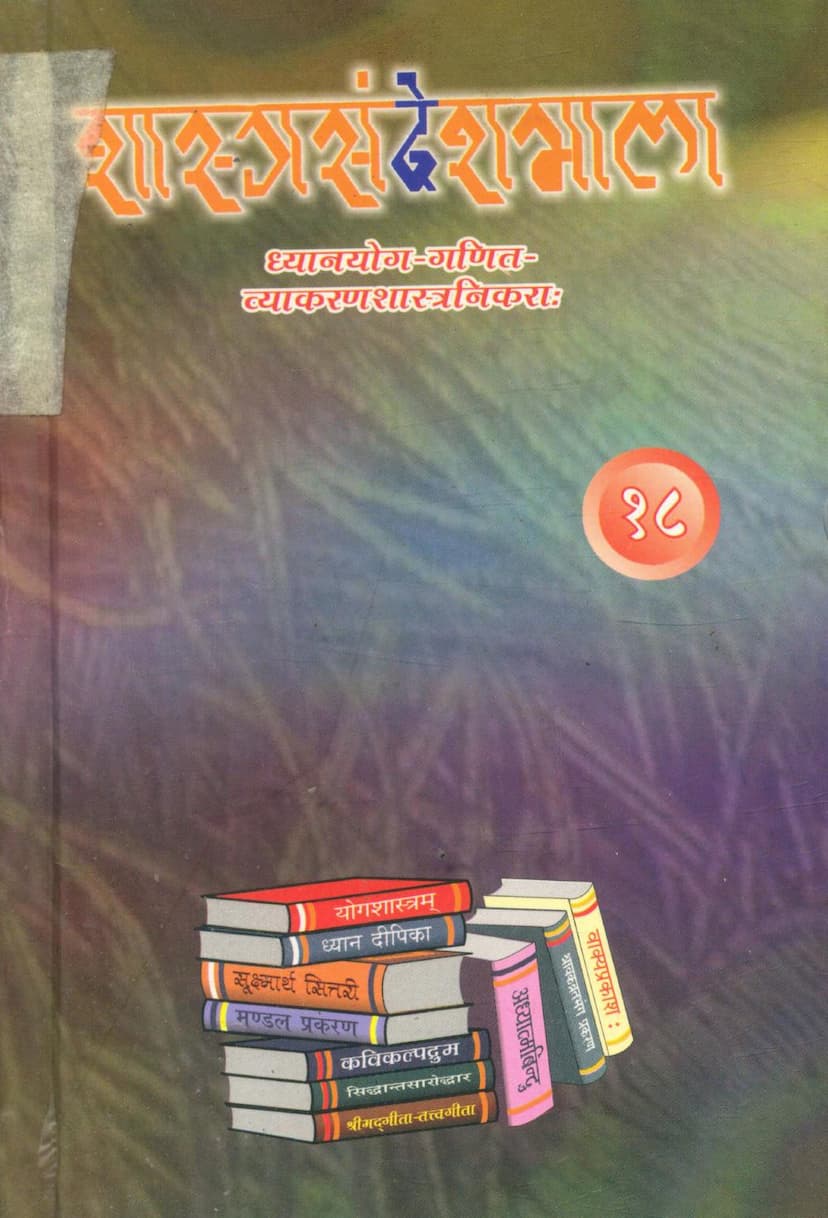Shastra Sandesh Mala Part 18
Added to library: September 2, 2025

Summary
Here's a comprehensive summary of the Jain text "Shastra Sandesh Mala Part 18," authored by Vinayrakshitvijay, based on the provided text:
Overall Purpose and Content:
"Shastra Sandesh Mala Part 18" is a compilation of Jain scriptures focusing on Dhyanayoga (Meditation and Yoga), Ganita (Mathematics), and Vyakarana (Grammar). This particular volume, compiled by the esteemed Muni Shri Vinayrakshitvijayji M.S., under the guidance of Punyapada Nyasashri Bodhiratnavijayji M.S., aims to make the profound teachings of ancient Jain Acharyas accessible to a wider audience in a new, usable format. The publication is a testament to the dedication of the authors and publishers in preserving and disseminating Jain knowledge.
Key Themes and Sections:
The book is structured into three main sections, each dedicated to one of the core subjects:
1. Dhyanayoga (Meditation and Yoga):
This section delves into various aspects of spiritual practice and inner contemplation. It includes works that focus on:
- Adhyatmabindu (The Essence of the Self): Explores the nature of the soul, the distinction between the self and the non-self, and the path to liberation. It emphasizes the importance of self-realization and the detrimental effects of attachment and delusion.
- Samvegamrutam (The Nectar of Urgency/Renunciation): Focuses on cultivating detachment from worldly pleasures and experiences, highlighting the transient nature of life and the urgency of spiritual pursuit.
- Dhyana Deepika (The Lamp of Meditation): A detailed guide to meditation practices, explaining their importance for inner purification, concentration, and the realization of the soul's true nature. It discusses various types of meditation and their benefits.
- Chittashuddhiphalam (The Fruit of Mind Purification): Addresses the process of purifying the mind from negative emotions and impurities, emphasizing its crucial role in spiritual progress.
- Yogashastram (The Scripture of Yoga): A comprehensive work on yoga, likely covering yogic postures, breathing techniques (pranayama), concentration, and the ultimate goal of spiritual union and liberation.
- Shrimad Gita-Tattva Gita (The Essence of the Bhagavad Gita): While referencing the Gita, this section within a Jain context likely interprets its philosophical concepts through a Jain lens, possibly focusing on themes of duty, detachment, and the nature of reality from a Jain perspective.
2. Ganita (Mathematics):
This section showcases the Jain tradition's deep engagement with mathematics, presenting texts that cover:
- Siddhanta Saroddhara (The Essence of Siddhantas): Deals with foundational principles of Jain cosmology, astronomy, and possibly arithmetic and geometry as they relate to these subjects.
- Namaskar Stava: While primarily a devotional hymn, its inclusion here might suggest a mathematical or structural analysis of the Namokar Mantra or related devotional compositions.
- Mandala Prakaranam (Chapter on Mandalas): Likely explains the creation and significance of various geometric diagrams (mandalas) used in Jain rituals, art, or meditative practices, potentially involving mathematical calculations.
- Jivadigganita Sangraha Gatha: A collection of verses on mathematics related to the soul and other fundamental Jain categories, suggesting the application of mathematical principles to understand Jain philosophy.
- Dhanuhprushthabahusangraha Gatha, Pratarpramana Sangraha Gatha, Ghanaganita Sangraha Gatha: These titles indicate specific areas of mathematical study, possibly involving geometry ( dhanuhprushtha - bow-back, pratarpramana - measure of a plane), and algebra or higher mathematics (ghanaganita - solid geometry).
- Sukshmartha Saptati Prakaranam: A text containing seventy verses on subtle or profound meanings, possibly related to mathematical concepts or their philosophical implications.
3. Vyakarana (Grammar):
This section focuses on the principles and nuances of Sanskrit grammar, crucial for understanding the Jain scriptures:
- Kavikalpha Drumah (The Wish-Fulfilling Tree of Poets): Suggests a work on Sanskrit grammar that aids in poetic composition, likely explaining grammatical rules and their application in creating elegant verse.
- Shrikanta Vibhrama Sutra: The exact content is not detailed, but its placement in the grammar section suggests it deals with grammatical rules, possibly related to the usage of certain words or constructions.
- Vakya Prakasha (The Illumination of Sentences): A text focused on sentence structure, syntax, and the correct formation of meaningful sentences in Sanskrit.
- Samjna Adhikara: A chapter or section dedicated to grammatical terms and their definitions, a fundamental aspect of any grammar treatise.
- Parishishta-1: Indicates an appendix or supplementary material related to grammar.
Overall Compilation and Presentation:
The book highlights the meticulous work of collation and purification by esteemed scholars. It also acknowledges the generous contributions of various Jain Sanghas and trusts that funded the publication through their "Gnanadravya Nidhi" (funds for knowledge dissemination). The dedication and effort involved in typesetting, printing, and binding are also appreciated, ensuring the quality and accessibility of this valuable compilation.
Underlying Philosophy:
The introductory pages, particularly page 5, emphasize the paramount importance of Swadhyaya (Self-Study), equating it to the root of all virtues and a cause for significant spiritual merit (Nirjara). It stresses the study of scriptures related to spirituality, meditation, and yoga, advising adherence to the guidance of qualified Gurus. This underscores the book's commitment to not just presenting texts but also guiding the reader towards their proper study and assimilation.
In essence, "Shastra Sandesh Mala Part 18" serves as a significant resource for Jain scholars and practitioners, offering a structured and accessible gateway to key areas of Jain philosophical and linguistic study, with a strong emphasis on the path of meditation and self-realization.